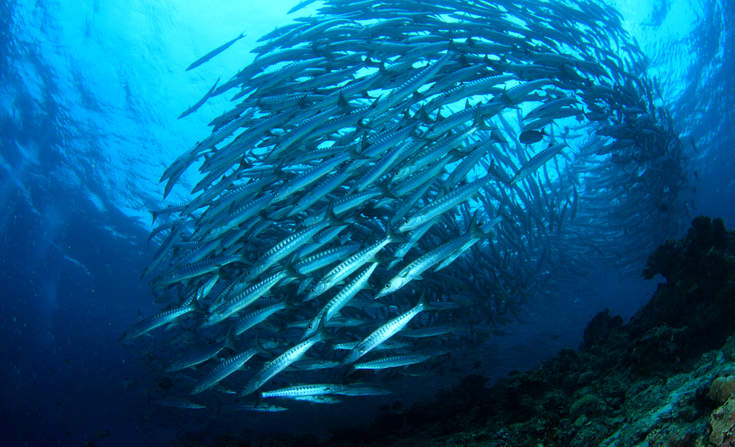 |
| Reviews and Templates for Expression We |
Tapping into Nature: Fluid dynamics
This is an excerpt from the Tapping into Nature report by Terrapin Bright Green.
Fluid dynamics describes how liquids and gases move and aims to limit the effects of drag. Every object in motion encounters the momentum-sapping effects of friction and drag from surrounding fluids.
Modern society uses excessive amounts of energy to overcome these effects in many industries. From single cells to humpback whales, organisms move fluids — and move through them — using minimal energy. Studying their movements helps improve the energy profile of companies in industries such as utilities, warehouse and distributions, manufacturing and transportation.
Strategies
Vortical flows

According to a research team at California Institute of Technology, jellyfish-inspired pulsed jet propulsion could be 50 percent more efficient than existing steady jet propulsion.
Vehicles, structures and industrial equipment such as pipes, ducts, engines and turbines are often streamlined to create idealized laminar flow but suffer energetic losses or mechanical failure when these flow patterns break down. Animals and other organisms leverage idealized vortical flows such as spiraling eddies. By exploiting or even creating vortices instead of trying to avoid them, flocking birds, swarming insects, schooling fish and the human heart are able to move through fluid and move fluid with minimal energy expenditure. Companies such as PAX Scientific are using these insights to provide new, low-energy processes and increased power production.
Constructal theory
Fluid flow in nature always follows the most efficient path. This phenomenon can be described by constructal theory — the study of how living and nonliving systems in nature optimize flow systems. The flow of air in human lungs, nutrients in leaves and water in river deltas follows this principle, balancing various flow resistances to create systems that minimize expended energy. Flow resistances are any aspect of the system that interact with the fluid’s movement; optimizing these simultaneously will result in designs with superior performance. Harbec is using constructal theory in the design of their injection molds, mimicking vascular systems to move coolant, and thus thermal energy, more effectively.
Existing products
Lily Impeller

Lily Impeller
Fans, mixers, pumps and propellers all aim to move fluid — air, water and the like — using as little energy as possible.
The Lily Impeller designed by PAX Scientific, a California-based technology firm, creates spiraling flows to move fluid. The same strategy — using vortices — is employed by birds in flight and schools of fish. The importance of this spiraling design is that it allows fluid to flow with reduced friction, minimizing the energy needed to move material from one point to another. PAX’s technologies are tailored for specific industries, offering reduced energy inputs, reduced operating noise and efficient mixing over conventional technology. PAX Water — aimed at water and wastewater treatment — effectively can circulate 10 million gallons of water using the same power as three 100-watt light bulbs. This is much less power than conventional technology requires and has been installed at 1,000 sites. PAX Mixer technologies — focused on industries where fluid mixing is critical — are able to reduce required energy inputs, capital costs and mixing time while increasing product yields.
Tubercle Technology

Tubercle Technology
Commercialized by Toronto-based WhalePower, Tubercle Technology emulates the vortex-forming bumps on humpback whale fins. The small vortices created by whales’ tubercles delay stalling effects, permitting a 40 percent increase in the angle of attack before flow separation occurs and reducing drag by 30 percent. Envira-North Systems has partnered with WhalePower to use this technology in high-volume, low-speed ceiling fans.
Compared to conventional fans, these tubercle-enabled fans reduce power consumption by 20 percent and reduce operating noise. WhalePower is also commercializing their technology for the wind energy industry, providing reductions in both turbine noise and mechanical fatigue.
Products in development
Wind farms

Wind Farms
Unlike horizontal-axis wind turbines (HAWTs), which are costly to purchase, install and maintain and require large expanses of land, vertical-axis wind turbines (VAWTs) offer closer spacing, omnidirectional operation and lower capital and maintenance costs. John Dabiri at CalTech has patented a bioinspired design for VAWT farms. Informed by the vortices of schooling fish, Dabiri has shown that counter-rotating, closely spaced turbines minimize the negative effects of turbulence in VAWT farms.
Although VAWT farms produce less power output overall, the spatial arrangements recommended by Dabiri result in wind farm power densities that are 10 times higher than HAWT farms (30 W/m2 compared to 3 W/m2), decreasing a system’s footprint and enabling medium and large sized VAWT installations to be more readily adopted. Dabiri’s designs have been implemented at an existing wind farm to improve power density and in Igiugig, Alaska, to provide high power output in this remote village. This innovative approach yields reductions in cost, wind farm size and environmental impacts.
|
|
|
|
Copyright remains with the original authors |
